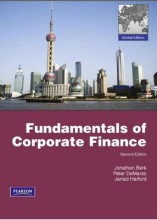Summary: Strategic Management Competitiveness And Globalization
- This + 400k other summaries
- A unique study and practice tool
- Never study anything twice again
- Get the grades you hope for
- 100% sure, 100% understanding
Read the summary and the most important questions on Strategic Management Competitiveness and Globalization
-
1 Strategic management and strategic competitiveness
This is a preview. There are 30 more flashcards available for chapter 1
Show more cards here -
What is strategic competitiveness?
Strategic competitiveness is achieved when a firm successfully formulates and implements a value-creating strategy. -
What is risk in strategy?
Risk is an investor's uncertainty about the economic gains or losses that will result from a particular investment. -
What are average returns?
Average returns are returns equal to those an investor expects to earn from other investments with a similar amount of risk. -
Characteristics of the current competitive landscape
- financial capital is scarce
- markets are increasingly volatile
- conventional sources of competitive advantage (economies of scale) are uneffective
- governments are involved -
Technology trends can be placed into two categories:
1. Technology diffusion and disruptive technologies
2. Information age and increasing knowledge intensity -
The rate of technology diffusion
The speed at which new technologies become available and are used. -
I/O model of above-average returns
Performance is determined by range of industry properties; economies of scale, barriers to market entry, diversification, product differentiation and concentration degree firm.
1. External environment imposes pressures and constraints
2. Most firms control similar strategically relevant resources and pursue similar strategies because of 1
3. Resources used to implement strategies are highly mobile across firms
4. Challenges firms to find most attractive industry to compete in and shape that industry to their advantage.
Model suggests that returns are determined primarily by external characteristics rather than by the firm's unique internal resources and capabilities. -
The resource-based model of above-average returns
Each organization is a collection of unique resources and capabilities and this uniqueness is the basis for a firm's strategy.
1. Differences in performance occur primarily because of firm's unique resources and capabilities
2. Firms acquire different resources and develop unique capabilities based on how they combine/use resources
3. Resources and certainly capabilities are not highly mobile across firms.
4. Differences in resources and capabilities are the basis of competitive advantage. -
4 steps to identify profit pools
1. define pool's boundaries
2. estimate pool's overall size
3. estimate size of value-chain activity in pool
4 reconcile the calculations -
1.1 The global economy
This is a preview. There are 1 more flashcards available for chapter 1.1
Show more cards here -
What is global economy?
A global economy is one in which goods, services, people, skills and ideas move freely across geographic borders.
- Higher grades + faster learning
- Never study anything twice
- 100% sure, 100% understanding





























